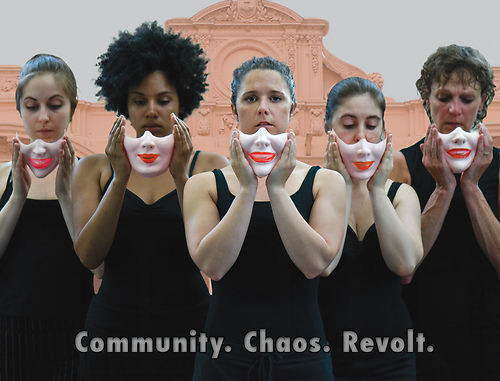No, this is not a post about Madonna who sang Don’t cry for me Argentina and played the character of Evita.
I watched a dance performance by Anabella Lenzu Dance/Drama this weekend at the Merce Cunningham Studio in the West Village. I hadn’t been back to the Cunningham space since March and Merce Cunningham died this summer. The space felt really strange without Merce’s presence.
The premise for The Corral was the Ms Lenzu’s experience with “El Corralito” – the 2001 political uprising in Argentina, a result when the government froze all bank accounts overnight, robbing the entire nation of its assets. According to the press release: “Is your homeland part of your identity? Where is your home once you have left your homeland behind?” I am really interested in ideas of patriotism and nationalism in the global community so that piqued my interested and convinced me to come see The Corral.
The piece combined text and dance to create another layer of drama and meaning to the piece. Many props were involved such as red stools, green towels, 1/2 masks with plastered smiles to illustrate the ideas of revolt, confusion, censorship. At times the props felt like I was being beat over the head by imagery at other times it added a layer of dramatic effect. The masks were creepy and the dancers eyes were screaming “help me!” while the plastered smiles were plastic and glued on. This is reminiscent to old jazz dance routines from when I was a child with flashy costumes. My teacher told us to “smile big”. All that smiling could drive any person crazy.
The movement patterns started bound, heavy, and restrained in the beginning of the hour long piece to light, upward motion, and plenty of releve. There was a section that depicted a group of people watching a soccer game followed by a victory dance that provided comic relief. The transitions were choppy at best and the music made you feel like you’re in an Argentinean milonga where club-goers can watch others dance the tango (or participate themselves). The tango comes from a very political background that is sensual yet powerful. There was a moment when all the dancers repeated the universal sign for stop in The Corral. A symbolic gesture for a stop to the tyranny? a revolt? deception?
Dancers spat at the ground, stomped, ran around, fell to the ground, linked arms and shifted the positions of the stools. The spitting was reminiscent of disrespect for another person’s culture. The cast of dancers were varied in their performance maturity. Some of the dancers really understood the feelings of anger, power, elation, fear, and hope.
At the end of the piece, the dancers linked arms and heads were faced upwards as if to beckon to the heavens above.

Photography by Todd Carroll








